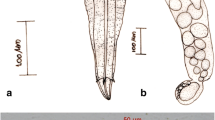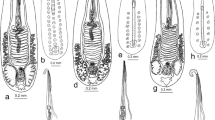Abstract
The life cycle of Neocladocystis intestinalis (Vaz, 1932) was resolved experimentally. The prosobranchiate snail Aylacostoma chloroticum Hylton Scott (Thiaridae) collected in the Yacyretá Dam, Province of Misiones, Argentina, was found naturally infected with cercariae that possessed pigmented eye spots, 7 pairs of penetration glands, 12 pairs of flame cells, and a V-shaped, or Y-shaped excretory vesicle with very short stem. The cercariae developed in oval cysts, which were found on fin rays, and under scales of naturally and experimentally exposed tetragonopterid fish species and of experimentally exposed poecilid and prochilodont fish species. Adults were obtained experimentally from juvenile Salminus brasiliensis (Characidae), bred in captivity, and infected with metacercariae from albino Gymnocorymbus ternetzi (Tetragonopteridae), which had been exposed to emerging cercariae.


Similar content being viewed by others
References
Braun M (1902) Fascioliden der Vögel. Zool Jahrb, Abt Syst 16:1–162
Brasil-Sato MC (2002) Digenea of Salminus brasiliensis (Cuvier, 1817) (Osteichthyes, Characidae) of the Sao Francisco River Basin, Brazil. Brazil J Vet Parasitol 11:95–98
Cribb TH (1986) The life cycle and morphology of Stemmatostoma pearsoni, gen. et sp. nov., with notes on the morphology of Telogaster opisthorchis Macfarlane (Digenea: Cryptogonimidae). Australian J Zool 34:279–304
Hylton Scott MI (1953) El género Hemisinus (Melaniidae) en la costa fluvial argentina. Physis 20:438–443
Hylton Scott MI (1954) Dos nuevos melánidos del Alto Paraná. Neotrópica 1:45–48
Jimenez GMI (1993) Fauna helmintológica de Cichlasoma fenestratum (Pisces: Cichlidae) del lago de Catemaco, Veracruz, México. An Inst Biol UNAM, Ser Zool 64:75–78
Kohn A, Fernandes BMM (1987) Estudo comparativo dos helmintos parasitos de peixes do Rio Mogi Guassu, coletados nas excursoes realizadas entre 1927 e 1985. Mem Inst Oswaldo Cruz 82:483–500
Kohn A, Fernandes BMM, Cohen SC (2007) South American Trematodes parasites of fishes. Fundação Oswaldo Cruz. Conselho Nacional de Desenvolvimento Científico e Tecnológico, Brazil, 318 pp
Kohn A, Fernandes BMM, Macedo B, Abramson B (1985) Helminths parasites of freshwater fishes from Pirassununga, SP, Brazil. Mem Inst Oswaldo Cruz 80:327–336
Manter HW, Pritchard M (1969) Some digenetic trematodes of Central Africa chiefly from fishes. Rev Zool Bot Afr 80:51–61
Miller TL, Cribb TH (2008) Family Cryptogonimidae Ward, 1917. In: Bray RA, Gibson DI, Jones A (eds) Keys to the Trematoda, vol. 3. CABI Publishing, Wallingford, U.K., pp 51–112
Odening K (1970) Der Entwicklungszyklus von Apophallus muehlingi (Trematoda: Opisthorchiida: Heterophyidae) in Berlin. Ztschr Parasitenk 33:194–210
Odening K (1973) Der Lebenszyklus des Trematoden Apophallus donicus in Berlin im Vergleich zu A. muehlingi. Biol Zentralbl 92:455–494
Ostrowski de Núñez M (1987) Der Entwicklungszyklus von Acanthostomum brauni Mañé Garzón und Gil, 1961 (Trematoda, Acanthostomatidae). Zool Anz 218:273–286
Ostrowski de Núñez M (1992) Life History Studies of Heterophyid Trematodes in the Neotropical Region: Ascocotyle (Leighia) hadra sp. n. Mem Inst Oswaldo Cruz 81:539–543
Ostrowski de Núñez M (1995) Life History of Pygidiopsis crassus n.sp. (Trematoda, Digenea, Heterophyidae) in the Neotropical Region. Mem Inst Oswaldo Cruz 90:13–19
Ostrowski de Núñez M (1998) Life Cycle of Ascocotyle (Phagicola) angeloi (Digenea: Heterophyidae) in the Neotropical Region. Folia Parasitologica 45:199–204
Ostrowski de Núñez M, Gil de Pertierra AA (1991) The life history of Acanthostomum gnerii Szidat, 1954 (Trematoda: Acanthostomatidae), from the catfish Rhamdia sapo in Argentina. Zool Anz 277:58–71
Ostrowski de Núñez M, Gil de Pertierra AA (2004) Ciclos Biológicos dulceacuícolas de Digenea (Trematoda) y Proteocephalidea (Cestoda). In: Lizama P (ed) Sanidade de Organismos Aquáticos. M. J. T. Ranzani-Paiva, R. M. Takemoto, M.de los A. Editora Varela, São Paulo, Brazil, pp 215–257
Ostrowski de Núñez M, Quintana MG (2008) The life cycle of Stephanoprora aylacostoma n. sp. (Digenea: Echinostomatidae), parasite of the threatened snail Aylacostoma chloroticum (Prosobranchia, Thiaridae), in Argentina. Parasitol Res 102:647–655
Ostrowski de Núñez M, Semenas L, Brugni N, Viozzi G, Flores V (1999) Redescription of Acanthostomoides apophalliformis (Trematoda, Acanthostomidae) from Percichthys trucha (Pisces, Percichthyidae) with notes on its life cycle in Patagonia, Argentina. Acta Parasitologica 44:222–228
Prudhoe S (1951) Trematoda, Cestoda and Acanthocephala. Exploration Hydrobiologique du LacTanganyka 3:1–10
Quintana MG, Mercado Laczkó AC (1997) Caracoles de los rápidos en Yacyretá. Ciencia Hoy, Buenos Aires 7:22–31
Quintana MG, Ostrowski de Núñez M (2014) The life cycle of Pseudosellacotyla lutzi (Digenea: Cryptogonimidae), in Aylacostoma chloroticum (Prosobranchia: Thiaridae), and Hoplias malabaricus (Characiformes: Erythrinidae), in Argentina. J Parasitol 100:805–811
Ramos RP (1995) Algunos tremátodos de vertebrados de la Presa Miguel Alemán, en Temascal, Oaxaca. An Inst Biol UNAM, Ser Zool 66:241–246
Scholz T, Vargas-Vásquez J, Moravec F, Vivas-Rodriguez C, Mendoza-Franco E (1995) Metacercariae of trematodes of fishes from cenotes (=sinkholes) of the Yucatan Peninsula, Mexico. Folia Parasitologica 42:173–192
Scholz T (2008) Family Opisthorchiidae Looss, 1899. In: Bray RA, Gibson DI, Jones A (eds) Keys to the Trematoda, vol. 3. CABI Publishing, Wallingford, U.K., pp 9–49
Simone LRL (2006) Land and freshwater molluscs of Brazil. Editora Gráfica Bernard Ltda. Fundaçao de Amparo a Pesquisa do Estado de Sao Paulo, Sao Paulo, Brazil, p 390
Stoyanov B, Neov B, Pakov P, Rdoslavov G, Hristov P, Georgiev BB (2015) Redescription of Aphalloides coelomicola Dollfus, Chabaud & Golvan, 1957 (Digenea, Opisthorchioidea) based on specimens from Knipowitschia caucasica (Berg) (Actinopterygii, Gobionellidae) from a Black Sea lagoon, with comments on the systematic position of the genus. Syst Parasitol 91:1–12
Travassos L, Artigas P, Pereira C (1928) Fauna helmintológica dos peixes de água doce do Brasil. Arch Inst Biol, S Paulo 1:5–69
Travassos L, Freitas JFT, Kohn A (1969) Trematodeos do Brasil. Mem Inst Oswaldo Cruz 67:1–886
Vaz Z (1932) Contribuiçao ao conhecimento dos Trematoides de peixes fluviaes do Brasil. Inaug. Diss, São Paulo, p 47
von Ihering H (1902) As melanias do Brazil. Rev Museu Paulista 5:653–682
von Ihering H (1909) Les mélaniidés américains. J Conchyl 57:289–316
Yamaguti S (1975) A synoptical review of life histories of digenetic trematodes of vertebrates. Keikagu Publishing Co., Tokyo, Japan, 591 p
Acknowledgments
We are indebted to Lic. D. C. Pérez and Lic. L. Cardinale (Entidad Binacional Yacyretá) for their kind help in snail collection by diving and in obtaining the juvenile S. brasiliensis from the Estación de Piscicultura de San Cosme y Damián (EBY Paraguay), to the ichthyologists of the Universidad Nacional de Misiones, Lic. D. R. Aichino, Lic. M. F. Benitez, and A. S. Masin for their effort to capture fishes in the dam using different fishing gear, to Lic. A. C. Mercado Laczkó for helping in the preparation of figures, and to Dr. S. Amato (Brazil) for providing important literature. Funds and facilities for this work were provided by EBY (Yacyretá Binational Entity); the authors are sincerely grateful for their continued support to the Aylacostoma Program in Yacyretá.
Author information
Authors and Affiliations
Corresponding author
Rights and permissions
About this article
Cite this article
Quintana, M.G., Ostrowski de Núñez, M. The life cycle of Neocladocystis intestinalis (Vaz, 1932) (Digenea: Cryptogonimidae), in Aylacostoma chloroticum (Prosobranchia: Thiaridae), and Salminus brasiliensis (Characiformes: Characidae), in Argentina. Parasitol Res 115, 2589–2595 (2016). https://doi.org/10.1007/s00436-016-5004-7
Received:
Accepted:
Published:
Issue Date:
DOI: https://doi.org/10.1007/s00436-016-5004-7




